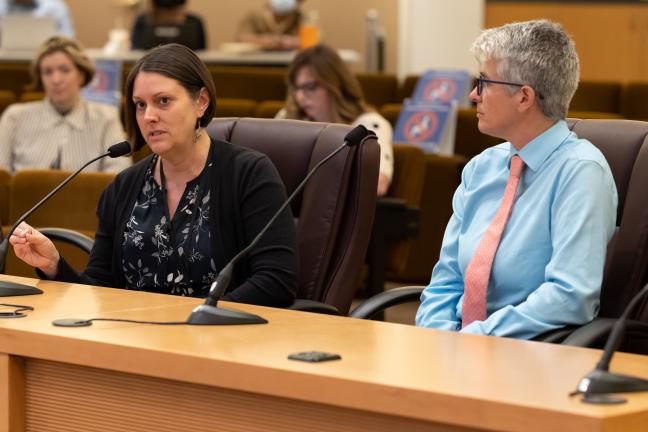Public health experts on Tuesday, Aug. 16, briefed the Board of Commissioners on the County’s hMPXV (monkeypox) response, detailing the impact of the illness in Multnomah County and the Health Department’s long-term strategy.
Tuesday’s briefing comes as numerous jurisdictions declare states of emergency to help limit the spread of the virus. Nearly 9,500 hMPXV cases have been confirmed in the United States so far. As of Tuesday, Multnomah County had identified 69 cases and vaccinated at least 1,500 individuals.
“The current outbreak began probably in April this year in Western Europe and has most heavily impacted our community of gay, bisexual and other men who have sex with men, but it is certainly not limited to that group and can infect anybody,” said Dr. Teresa Everson, the County’s deputy health officer.
HMPXV is a rash illness caused by a virus related to, but different from, smallpox. It’s most often spread by direct skin contact with the rash/sores of an infected person. There is a much smaller risk of spread from sharing bedding or clothing or from having prolonged close respiratory contact.
The main symptom of hMPXV is a rash that progresses into sores. The illness can include a fever and other flu-like symptoms. Symptoms usually start within three weeks of exposure. Most people do not need specialized treatment or require hospitalization.
Health officials said they wanted to be clear that there is nothing specific about people who have sex with men that puts someone at higher risk for getting the virus. It’s just that gay, queer and trans communities happen to be the first socially connected networks affected in this outbreak.
County public health experts recognize community concern both about getting a new infection as well as being stigmatized. “There is the threat, along with the trauma and the fatigue,” Everson said.
Officials outline public health strategy
One of the County’s primary goals is to stop transmission and reduce suffering and severe disease. To achieve that goal, the County is testing people who are symptomatic so they can isolate themselves and receive treatment if needed.
Case investigators are also identifying people who have been in contact with people infected with the virus and working to ensure people know how to isolate. Staff help those known contacts monitor their own signs and symptoms so they can test and isolate quickly if needed.
“How soon after exposure will a test pick up the presence of the virus?” Commissioner Susheela Jayapal asked.
“As soon as you have a rash,” Everson said.
The County is focused on contacting, educating and protecting the broader social networks who have the highest risks of exposure. That involves culturally specific messaging on reducing risks and improved access to vaccines. To date, the Health Department has met with numerous BIPOC and LGBTQ+ community-based organizations and coalitions and worked with community messengers.
“Those are going to be really important conversations and really kind of critical, in terms of making sure we’ve got the right messengers and it’s approached in the right way,” Commissioner Jessica Vega Pederson said.
“I appreciate the effort to tailor messaging,” Commissioner Sharon Meieran said. “Some people in groups at the highest risk have a lot of fear and misinformation and don’t know where to go.”
Multnomah County vaccinating those at highest risk
A vaccine was approved in 2019 to prevent smallpox and hMPXV in people 18 or older who were determined to be at high risk for infection. The vaccine is administered beneath the skin, also known as subcutaneously, in two doses four weeks or 28 days apart.
Vaccine allotment and distribution is tightly controlled. The Health Department delivered its first vaccine dose July 5. In mid-July, the Oregon Health Authority increased the supply of vaccine reaching Multnomah County, enabling the Health Department to host twice-weekly community vaccine clinics.
“I hope that as we have more vaccine, the eligibility criteria will become more broad. And when it does, it will become a lot more simple,” said Kim Toevs, the County’s communicable disease and harm reduction director.
People exposed to the virus and who might need vaccines are urged to call the Health Department’s Call Center at 503-988-8939. Call center staff screen callers for vaccine eligibility and can register them for vaccination. They can also refer callers to testing options and answer other questions.
The County’s vaccine strategy follows Oregon Health Authority guidance. Currently the County is prioritizing using its limited supply of vaccines to provide first doses to eligible community members and anyone who has been recently exposed. Second doses are being deferred for those who are not at high risk of severe disease.
Vaccine distribution will expand to larger health systems and others as soon as more vaccines arrive from the federal government. The State is expecting a shipment of vaccines this week, which would add 5,000 vials to the County’s inventory.
For now, the County is focused on working through its vaccine waitlist, currently at 1,500 people. Moving forward, officials will continue to contact, educate, and protect those at the greatest risk.
“We need to be aware that if the disease changes, in terms of different communities it may move into,” Toevs said, “obviously our strategies will change.”
Chair Deborah Kafoury thanked the presenters while acknowledging the stress that the outbreak has added to a public health system already strained by numerous crises, including the ongoing COVID-19 pandemic.
“It really wasn’t the best time for this to come along,” Chair Kafoury said. “My kudos to you, your team, and the staff of Multnomah County who I know who are working so very hard.”
Learn more here about how hMPXV spreads and how to get a vaccine.